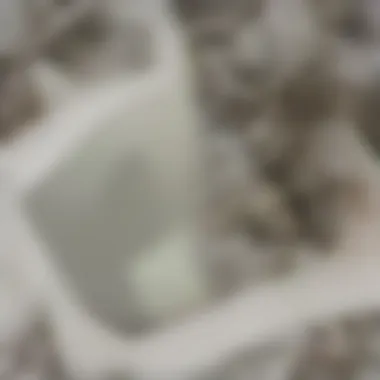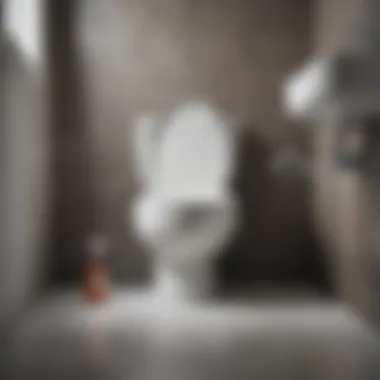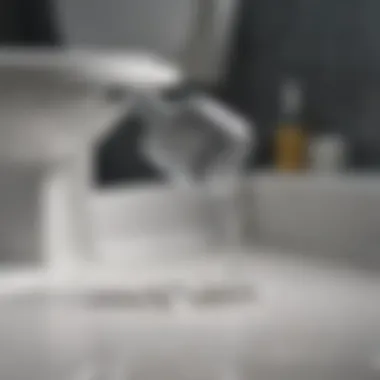Effective Ways to Unclog Your Toilet Without a Plunger


Intro
Dealing with a clogged toilet can be frustrating and inconvenient. However, many homeowners do not realize that a plunger is not the only tool available to address this issue. There are various alternative methods for unclogging a toilet, many of which utilize common household items. This article presents a detailed exploration of these techniques.
Understanding how to effectively handle a clog can save time and potential expenses associated with hiring a plumber. Moreover, being familiar with these methods allows individuals to approach such situations with confidence, minimizing stress.
Through this comprehensive guide, you will discover valuable insights into the common types of clogs and practical solutions that one can employ without relying on a plunger. Each method discussed will be accompanied by its benefits, potential drawbacks, and step-by-step instructions to ensure successful execution.
The knowledge imparted here will empower you to manage toilet clogs efficiently, transforming what can be an unpleasant situation into a manageable task.
Understanding Toilet Clogs
Toilets are essential in any home or establishment, and their proper functioning is crucial for daily operations. Understanding toilet clogs is a significant aspect of maintaining plumbing health. Clogs not only disrupt the convenience of modern life but can also lead to more serious plumbing issues. By recognizing the causes and signs of clogs early, individuals can mitigate risks, implement preventative measures, and use various techniques to manage minor problems without needing a plumber.
Understanding how clogs form helps in taking necessary action timely. This knowledge can save time and reduce frustration in emergencies. Knowledge of specific elements related to clogs informs readers on how to differentiate between minor and severe blockages. This insight prepares them for effective mitigation strategies that can prevent costly repairs or damage.
Common Causes of Clogs
Toilet clogs can arise from various sources, each with unique characteristics. Some common causes include:
- Excessive Toilet Paper: One of the most frequent culprits. Overuse can create dense masses, blocking the flow.
- Foreign Objects: Items like toys, wipes, or sanitary products can obstruct the toilet’s passage.
- Flushing Non-Flushable Items: Not all items are meant to be flushed. Items that do not break down easily lead to significant blockages.
- Mineral Buildup: Hard water can lead to mineral deposits, which accumulate over time and hinder water flow.
- Tree Roots: In older plumbing systems, tree roots can invade and block pipes, resulting in clogs.
Knowledge of these causes helps readers adopt mindful habits regarding what goes into their toilets.
Identifying Clog Severity
Not all clogs are the same; recognizing the severity is essential for appropriate action. Symptoms may range from minor issues that resolve quickly to serious blockages that require professional help.
- Minor Clogs: Slow draining water or occasional gurgling sounds often indicate minor issues. These can typically be addressed with simple methods like the hot water technique or baking soda and vinegar.
- Moderate Clogs: If multiple fixtures begin to drain poorly, or if water rises dangerously high in the bowl when flushed, the obstruction may be more significant. Addressing moderate clogs may need a combination of home remedies or tools like a plumbing snake.
- Severe Clogs: Signs such as frequent backflow, sewage smell, or water pooling suggest a severe issue. Such problems often require professional inspection.
Recognizing the type and severity of clogs allows for quicker resolutions and helps in determining when to seek professional assistance.
Safety Precautions
When dealing with a clogged toilet, it's essential to prioritize safety. Engaging with plumbing issues can be unexpectedly messy and even hazardous. Ensuring personal safety not only protects you but also helps avoid any additional damage to your bathroom or plumbing system. This section highlights key safety measures to adopt before starting the unclogging process.
Personal Protection Gear
Before diving into unclogging a toilet, wearing the right personal protection gear is crucial. This includes:
- Gloves: Using rubber or disposable gloves protects your hands from bacteria and unpleasant substances. It is wise to opt for durable gloves as you might encounter sharp objects or other debris.
- Face Mask: This helps reduce inhalation of unpleasant odors and potential splashes from the toilet. It is especially useful for sensitive noses or those who are susceptible to allergies.
- Eye Protection: Safety goggles can guard your eyes against any splashes or accidental contact with cleaning agents you might use in the process. This slight investment can prevent discomfort or injury.
The use of personal protection gear not only promotes hygiene but also provides peace of mind while you work on the clog.
Clearing the Area
Creating a suitable workspace in your bathroom prepares you for an efficient unclogging process. A clean and organized area minimizes distractions and dangers associated with the task. Here are key points to consider:


- Remove Items Around the Toilet: Take away any rugs, towels, or decorative items near the toilet. These can easily get ruined and create extra work later.
- Use Old Towels or Rags: Keep some old towels or rags handy. They can absorb spills and protect the flooring from any mess that might occur.
- Ventilation: Open windows or turn on exhaust fans to improve air quality. Ensuring fresh air circulation keeps the area comfortable and reduces odors during the unclogging process.
Important: Always ensure you have everything in place before you start. This approach saves time and minimizes interruptions.
By prioritizing safety precautions, you set a solid foundation for effectively tackling the issue at hand. Adopting these practices is essential for both your well-being and the overall success of unclogging your toilet.
Household Solutions for Unclogging
Household solutions for unclogging a toilet are essential due to their accessibility and effectiveness. Many homeowners face clogs but may not want to rely on a plunger. These methods utilize common household items, making them both economical and easy to implement. From hot water to baking soda, these solutions can tackle various clog scenarios without the need for specialized tools.
The benefits of using household items include safety and simplicity. Most products found at home have fewer harmful chemicals compared to commercial products. Also, they often do not require extensive troubleshooting knowledge, making them available for a wider range of people.
Hot Water Technique
Recommended Temperature
The hot water technique is effective in tackling mild blockages due to its ability to melt and dissolve waste materials. The recommended temperature for this method is generally around 120 to 140 degrees Fahrenheit. This specific range is ideal because it is hot enough to break down clogs without risking damage to the porcelain in most toilets.
Using water that is too hot can crack the bowl. The moderate temperature is advantageous as it provides enough heat to encourage substances to soften. It is a popular choice because most households have hot water readily available, requiring no extra purchases.
Method of Application
Applying hot water is straightforward yet impactful. To effectively implement this method, start by filling a bucket with hot water and carefully pour it into the toilet bowl from waist height. This allows the water to create force, helping to dislodge the clog.
The importance of careful pouring cannot be overstated. Pouring too aggressively may splash or send water back. Instead, a steady stream works better. Its unique feature is the ability to avoid harsh chemicals while still providing a substantial cleaning effect. However, caution is necessary — to avoid backlash and injury.
Baking Soda and Vinegar Method
Chemical Reaction Explained
The combination of baking soda and vinegar creates a powerful chemical reaction that helps break down clogs. When mixed, baking soda reacts with vinegar to produce carbon dioxide gas. This bubbling action helps to agitate and break apart waste material blocking the pipes.
This method stands out because it is natural and non-toxic, making it safer for both users and plumbing systems. Its effectiveness is often noted in various DIY circles, as it can clear grime and buildup over time. Nonetheless, timing is crucial. Allowing the reaction to sit for too long without flushing may re-solidify some debris.
Step-by-step Process
To effectively use this method, start by pouring one cup of baking soda into the toilet bowl, following it with one cup of vinegar. The bubbling chemical reaction begins shortly after the addition. Let the mixture sit for at least 30 minutes before flushing. This allows the components to work through the clog.
The process is straightforward, requiring minimal cleanup afterwards. A common concern about this method is that it may not work for severe clogs. However, it is often very effective for minor blockages.
Dish Soap Approach
Product Selection
Dish soap can be a surprisingly effective unclogging agent. The key is to choose a liquid dish soap that is specifically designed for grease removal. Brands like Dawn or Palmolive are often noted for their efficacy in such situations. This specific characteristic of these products breaks down greasy materials that may contribute to a clog's severity.
Furthermore, dish soap is safety to use. It will not harm plumbing systems like harsher chemicals. Its thick consistency provides a unique feature, allowing for prolonged contact with the clog. However, some may find it less effective if used alone on more solid blockages.


Effective Application
To apply this method, pour about half a cup of dish soap directly into the toilet bowl. Let it sit for about 15 minutes before flushing with hot water. The soap helps to lubricate and possibly break down the waste material. Its effectiveness lies partly in the simplicity of application. One must also ensure that the soap does not sit for too long to avoid excessive buildup.
The dish soap approach is favored more for its ease and the commonality of the product. While it may not always clear a severe clog, it can be a good first step before attempting more intricate methods.
Using Tools Complementary to DIY Methods
When faced with a clogged toilet, DIY methods can serve as the first line of defense. However, employing specific tools can significantly enhance your ability to effectively resolve such issues. Techniques like using a plumbing snake or a wet/dry vacuum, when applied correctly, offer powerful alternatives that can help prevent damage to your plumbing system. These tools not only save time, but they can also provide more thorough results than household remedies alone.
Plumbing Snake
Choosing the Right Type
Selecting the proper plumbing snake is crucial for dealing with toilet clogs. Various types exist, including hand-cranked and motorized snakes. Each type has its merits, but a hand-cranked model is often recommended for home use. Its simplicity allows for easy maneuvering, while minimizing the risk of damaging pipes.
The key characteristic of a hand-cranked plumbing snake is its flexibility. This allows it to navigate through bends in pipes, reaching clogs that other tools may not. With this type of snake, you benefit from a straightforward approach that requires no special training. However, one should be cautious; using it incorrectly can lead to further complications.
Using the Plumbing Snake Effectively
Understanding how to use a plumbing snake is essential for achieving satisfactory results. First, ensure that you insert the snake slowly into the toilet drain. This gradual approach minimizes the risk of mishandling. Once it meets resistance, begin to crank it while applying slight pressure. The idea is to break up the clog rather than force it, which could lead to pipe damage.
The effective feature of this method is its versatility. The plumbing snake can also work in various contexts beyond toilets, such as sinks or bathtubs. While a plumbing snake requires physical effort, its advantages are clear. It is less messy than liquids and chemical solutions while offering a more reliable clog removal method in many instances.
Wet/Dry Vacuum
Vacuum Settings
Using a wet/dry vacuum can be a highly effective solution for unclogging toilets. This tool is particularly powerful, provided you set it correctly. First, switch it to the liquid setting. Understanding how to operate it efficiently is vital, as improper settings could lead to further complications. It captures the clog while keeping your bathroom mess-free.
The unique feature of a wet/dry vacuum is its suction capability, allowing it to pull large amounts of material out of pipes without adverse effects on your plumbing. However, it is important to ensure that the nozzle fits snugly within the toilet bowl to avoid splatter and leaks.
Procedure for Safe Use
Following the right procedure ensures safety and effectiveness when using a wet/dry vacuum. Start by ensuring your vacuum is appropriate for the task. Plug it into a grounded outlet to reduce electrical hazards. Once ready, place the hose into the toilet bowl, being careful to position it at the drain opening.
This procedure is beneficial because it combines efficiency with safety. The wet/dry vacuum can handle large clogs or excess water without risk of overflows, avoiding some common pitfalls of attempting to manually clear a clog. However, a drawback could be its bulkiness, which makes it less convenient than simpler methods.
Pro Tip: Always consult the manufacturer's instructions for your equipment. This step can prevent accidents and ensure the best results.
By utilizing both a plumbing snake and a wet/dry vacuum, homeowners can tackle toilet clogs effectively. Understanding how to choose and use these tools provides more control over your plumbing issues and minimizes the chance of future complications.
Preventative Measures for Future Clogs
Preventative measures are vital to maintain a smoothly functioning toilet and to avoid the stress associated with sudden clogs. Understanding these practices helps homeowners and renters mitigate the risk of encountering unpleasant situations in the future. By implementing consistent habits, you can save time, money, and the discomfort of having to address clogs frequently.
Regular Maintenance Practices


Routine maintenance is essential for the longevity of your toilet’s plumbing system. The following practices are recommended:
- Routine Inspections: Regularly check for signs of leaks or wear in the toilet components. Look specifically at the tank, bowl, and connections. Catching these issues early can prevent them from escalating.
- Cleaning: Keep your toilet clean with a mild toilet cleaner. Avoid harsh chemicals, as they may deteriorate the internal parts over time. A clean toilet is less likely to develop clogs from mineral buildup or residue.
- Flush Once in a While: If your toilet is seldom used, flush it occasionally to prevent stagnant water. This action helps keep the pipes clear and maintains the integrity of the traps.
By incorporating these practices, you can significantly reduce the risk of clogs and extend the life of your toilet.
What Not to Flush
Understanding what should never be flushed down the toilet is crucial for preventing clogs. The following items frequently lead to problems:
- Sanitary Products: Items like tampons, pads, and similar products do not break down in water and can lead to serious clogs.
- Wipes: Even those labeled as "flushable" often do not disintegrate as intended, contributing to blockages.
- Paper Towels: Unlike toilet paper, paper towels do not dissolve easily and can lead to clogging.
- Cotton Balls and Swabs: These can also accumulate in pipes and create blockages over time.
- Food Waste: Although some toilets may allow for composting, food waste can cause plumbing issues.
Always remember: the toilet is not a trash can. Proper disposal of the above items can save you from encountering issues.
By adhering to these guidelines, you foster a clog-free environment for your plumbing system.
When to Seek Professional Help
Addressing a toilet clog can often be managed with simple household methods, but there are instances when the problem escalates beyond basic remedies. Understanding when to call in a professional can save time, money, and prevent further damage to your plumbing system. This section highlights critical issues that indicate the need for expert intervention.
Signs Indicating a Serious Problem
Several signs may indicate that your clog is not just a minor inconvenience:
- Repeated Clogs: If you find yourself experiencing multiple clogs in a short period, this could indicate a more serious issue in your plumbing system.
- Foul Odors: Persistent bad smells coming from the toilet or bathroom might suggest a blockage in the sewer line or vent stack.
- Gurgling Sounds: Unusual noises from the toilet or nearby drains often signal a blockage that could affect the plumbing system more broadly.
- Backing Up: If water backs up into sinks, tubs, or showers when you flush, it is a clear warning sign that professional help is necessary.
- Slow Draining: If the toilet takes a long time to drain, or doesn't clear completely, a more severe blockage could be blocking the drain.
Identifying these signs early can prevent further complications, leading to more expensive repairs.
Choosing a Reliable Plumber
When a clog becomes too complicated to handle yourself, selecting the right plumber is vital. Here are key considerations in the selection process:
- Experience and Qualifications: Look for a plumber with a solid track record. Experience in handling similar issues is a valuable asset.
- Licensing and Insurance: Ensure that the plumber is appropriately licensed and insured. This protects you from liability in case of an accident.
- Reviews and Recommendations: Seek testimonials from previous customers. Their experiences can provide insight into the plumber's reliability and effectiveness.
- Availability: A reliable plumber should have flexible hours and be available for emergency situations. Plumbing issues often require immediate attention.
- Written Estimates: Before any work begins, ask for a written estimate. This helps avoid surprise costs and provides clarity on what to expect.
- Warranty on Work: Inquire whether the plumber offers warranties on their services and parts. A good warranty indicates confidence in their work.
By carefully selecting a professional, you can ensure that the issue is resolved effectively and efficiently.
Culmination
In summary, the conclusion of this guide serves as a critical reflection on the effective techniques discussed for unclogging a toilet without a plunger. Understanding these methods not only empowers individuals to handle common plumbing issues but also fosters a sense of self-reliance in maintaining home facilities. Each technique has been articulated to ensure that readers can select the most suitable method for their specific situation.
Recap of Key Techniques
Here are the main strategies we explored in this article:
- Hot Water Technique: Use hot water to break down clogs effectively. Just be cautious with the temperature.
- Baking Soda and Vinegar Method: This method uses a chemical reaction to dissolve clogs. It is a classic yet effective solution.
- Dish Soap Approach: Dish soap can help lubricate and break down the materials causing the clog.
- Plumbing Snake: A flexible tool that can reach deep clogs that other methods can't.
- Wet/Dry Vacuum: For those who have one, this vacuum can suck out clogs safely and efficiently.
Reviewing these techniques can enhance one’s preparedness for future plumbing emergencies.
Final Recommendations
It is essential to approach unclogging with caution. Prioritize safety by wearing gloves and protective eyewear. When using household mixtures like baking soda and vinegar, ensure to allow sufficient time for the solution to work before attempting to flush the toilet. Should there be signs of severe blockage that persist despite these methods, do not hesitate to consult a professional plumber.
With these insights, individuals can tackle the challenge of unclogging a toilet with greater confidence and efficiency.







